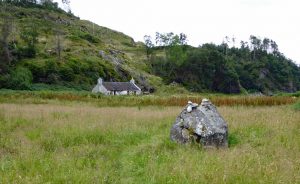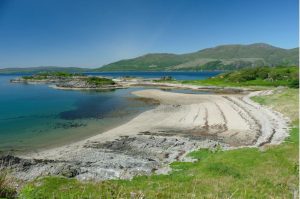‘Nowhere in all the West Highlands and Islands have I seen any place of so intense or varied beauty in so small a compass’
The inspiration for this walk…The Ring of Bright Water (1960)
This was very much my parents’ book, I had noticed it on the bookshelf at home, but it hadn’t really caught my imagination.
That is until we went for a family holiday in Scotland when I was seven, and one day trudged through the rain, protected by bright yellow sou’westers and heavy macs, to try and find the ruins of his cottage. All I can remember are the thousands of slugs on the track, which absolutely fascinated me.
I read the book when we got home and was entranced by it. But it has not stood the test of time well; his ascribing of human traits to the animals, although rather charming, now feels out of tune with the re-wilding and back to nature movement.

KEY DATA
- Terrain: Forest tracks
- Starting point: Leave Glenelg and travel around 5.6 km south along the road to Arnisdale and you come to Upper Sandaig on the right (a cottage just after a small loch). The Sandaig Bay forestry track, on the right just before the loch, is the start of the walk that takes you down to Sandaig.
- Distance: 4.2 km (2.6 miles)
- Walking time: 1 hr 21 mins
- OS Map: OS Landranger 33. The route can be found at https://explore.osmaps.com/en/route/10806393/Sandaig-Glenelg-The-Highlands-Gavin-Maxwell-Ring-of-Bright-Water
- Facilities: none
GAVIN MAXWELL (1914-1969)
Gavin Maxwell was a Scottish naturalist and author, best known for ‘The Ring of Bright Water’, the record of his life in the remote Sandaig (which he called Camusfeàrna in his books), where he kept several wild otters as pets. The book has sold over two million copies and was made into a very successful film in 1969. We all read it as children.
The book’s strength is its vivid description and ability to bring the otters to life:
‘I wangled him (Mij the otter) into my sleeper, and he wangled himself into my bed, so passed a pleasant journey. Here he has surpassed my wildest expectations. He comes for long cross-country walks without a lead and is utterly biddable… He is lamentably unable to catch fish or eels – he tries to play with them so of course they escape.’
OUR WALK
 Our aim is to reach the site of the lighthouse keeper’s cottage at the edge of the Sound of Sleet where he wrote the book. We take off down a forest track towards the bay.
Our aim is to reach the site of the lighthouse keeper’s cottage at the edge of the Sound of Sleet where he wrote the book. We take off down a forest track towards the bay.
As we reach the main beach, we are reminded of these lines of Maxwell’s: ‘Into this bright, watery landscape Mij moved and took possession with a delight that communicated itself as clearly as any articulate speech could have done. The waterfall, the burn, the white beaches and the islands; his form became the familiar foreground to them all.’ This is our same experience today.
We stand in front of the memorial stone that marks where Gavin Maxwell’s ashes are buried and also the spot where his writing desk was placed in the cottage before it was burnt down in 1967. The inscription on the stone reads:
‘Beneath this stone,
the site of Camusfearna,
are buried the ashes of
GAVIN MAXWELL
b. 15th July 1914, d. 7th September 1969’
A few yards away towards the burn is a memorial to Edal, the otter that perished in the fire. The inscription reads:
‘EDAL
THE OTTER OF RING OF BRIGHT WATER
1958-1968
Whatever joy she gave to you, give
back to nature. GAVIN MAXWELL’
Also nearby and visible when not covered by bracken are the rusty remains of a boat trailer used for Maxwell’s boat, the Polar Star.
At the burn, we cross by a rather rickety rope bridge; there are also stepping-stones which you can use providing the burn has not been in spate. Upstream a short way there is a delightful waterfall, which Maxwell described as ‘the soul of Camusfearna’.
On the other side, you can turn right and take the shortcut back up to the forest track or head left and walk around to the islands. Around three hours on either side of low tide you can walk across to the first island with its tiny patch of Machair, adjacent white coral beach and stunning view North to Glenelg Bay. This makes an idyllic spot for a picnic.

OTHER STUFF
Visit: The Bright Water Centre at Eilean Bàn, which now supports a pier of the Skye Bridge. The island is a commemorative otter sanctuary and houses a museum dedicated to Maxwell, where he lived in the lighthouse after Sandaig was burnt down. www.eileanban.org



Leave a Reply